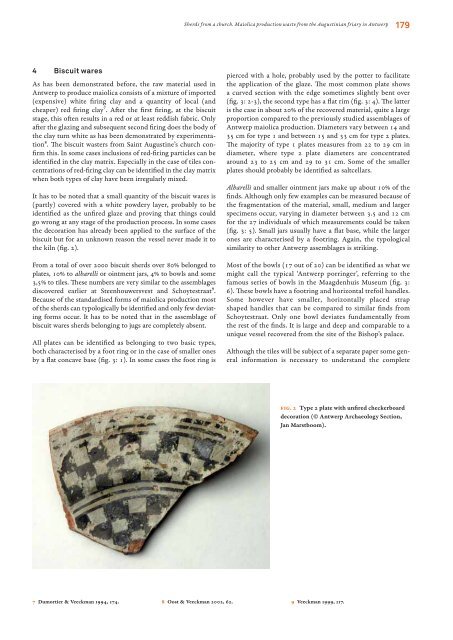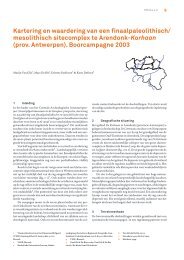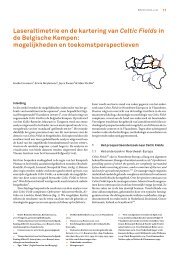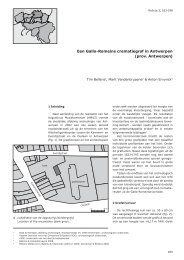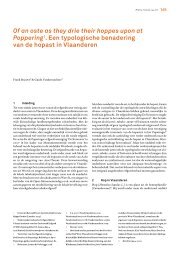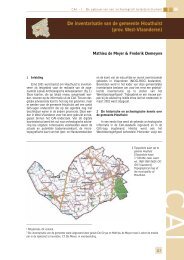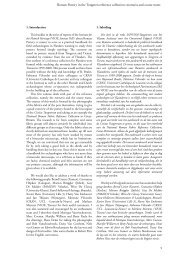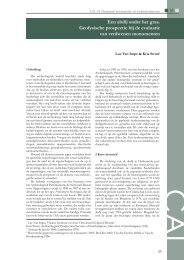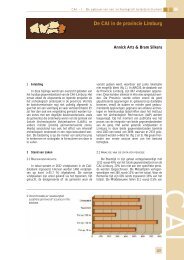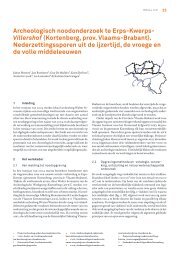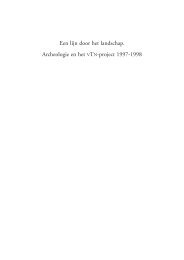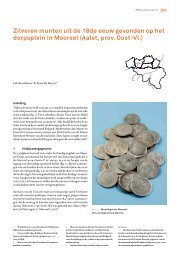Exchanging Medieval Material Culture Studies on archaeology and ...
Exchanging Medieval Material Culture Studies on archaeology and ...
Exchanging Medieval Material Culture Studies on archaeology and ...
You also want an ePaper? Increase the reach of your titles
YUMPU automatically turns print PDFs into web optimized ePapers that Google loves.
4 Biscuit wares<br />
As has been dem<strong>on</strong>strated before, the raw material used in<br />
Antwerp to produce maiolica c<strong>on</strong>sists of a mixture of imported<br />
(expensive) white fi ring clay <strong>and</strong> a quantity of local (<strong>and</strong><br />
cheaper) red fi ring clay7. Aft er the fi rst fi ring, at the biscuit<br />
stage, this oft en results in a red or at least reddish fabric. Only<br />
aft er the glazing <strong>and</strong> subsequent sec<strong>on</strong>d fi ring does the body of<br />
the clay turn white as has been dem<strong>on</strong>strated by experimentati<strong>on</strong>8.<br />
Th e biscuit wasters from Saint Augustine’s church c<strong>on</strong>fi<br />
rm this. In some cases inclusi<strong>on</strong>s of red-fi ring particles can be<br />
identifi ed in the clay matrix. Especially in the case of tiles c<strong>on</strong>centrati<strong>on</strong>s<br />
of red-fi ring clay can be identifi ed in the clay matrix<br />
when both types of clay have been irregularly mixed.<br />
It has to be noted that a small quantity of the biscuit wares is<br />
(partly) covered with a white powdery layer, probably to be<br />
identifi ed as the unfi red glaze <strong>and</strong> proving that things could<br />
go wr<strong>on</strong>g at any stage of the producti<strong>on</strong> process. In some cases<br />
the decorati<strong>on</strong> has already been applied to the surface of the<br />
biscuit but for an unknown reas<strong>on</strong> the vessel never made it to<br />
the kiln (fi g. 2).<br />
From a total of over 2000 biscuit sherds over 80% bel<strong>on</strong>ged to<br />
plates, 10% to albarelli or ointment jars, 4% to bowls <strong>and</strong> some<br />
3,5% to tiles. Th ese numbers are very similar to the assemblages<br />
discovered earlier at Steenhouwersvest <strong>and</strong> Schoytestraat9.<br />
Because of the st<strong>and</strong>ardised forms of maiolica producti<strong>on</strong> most<br />
of the sherds can typologically be identifi ed <strong>and</strong> <strong>on</strong>ly few deviating<br />
forms occur. It has to be noted that in the assemblage of<br />
biscuit wares sherds bel<strong>on</strong>ging to jugs are completely absent.<br />
All plates can be identifi ed as bel<strong>on</strong>ging to two basic types,<br />
both characterised by a foot ring or in the case of smaller <strong>on</strong>es<br />
by a fl at c<strong>on</strong>cave base (fi g. 3: 1). In some cases the foot ring is<br />
Sherds from a church. Maiolica producti<strong>on</strong> waste from the Augustinian friary in Antwerp 179<br />
pierced with a hole, probably used by the potter to facilitate<br />
the applicati<strong>on</strong> of the glaze. Th e most comm<strong>on</strong> plate shows<br />
a curved secti<strong>on</strong> with the edge sometimes slightly bent over<br />
(fi g. 3: 2-3), the sec<strong>on</strong>d type has a fl at rim (fi g. 3: 4). Th e latter<br />
is the case in about 20% of the recovered material, quite a large<br />
proporti<strong>on</strong> compared to the previously studied assemblages of<br />
Antwerp maiolica producti<strong>on</strong>. Diameters vary between 14 <strong>and</strong><br />
35 cm for type 1 <strong>and</strong> between 15 <strong>and</strong> 33 cm for type 2 plates.<br />
Th e majority of type 1 plates measures from 22 to 29 cm in<br />
diameter, where type 2 plate diameters are c<strong>on</strong>centrated<br />
around 23 to 25 cm <strong>and</strong> 29 to 31 cm. Some of the smaller<br />
plates should probably be identifi ed as saltcellars.<br />
Albarelli <strong>and</strong> smaller ointment jars make up about 10% of the<br />
fi nds. Although <strong>on</strong>ly few examples can be measured because of<br />
the fragmentati<strong>on</strong> of the material, small, medium <strong>and</strong> larger<br />
specimens occur, varying in diameter between 3.5 <strong>and</strong> 12 cm<br />
for the 27 individuals of which measurements could be taken<br />
(fi g. 3: 5). Small jars usually have a fl at base, while the larger<br />
<strong>on</strong>es are characterised by a footring. Again, the typological<br />
similarity to other Antwerp assemblages is striking.<br />
Most of the bowls (17 out of 20) can be identifi ed as what we<br />
might call the typical ‘Antwerp porringer’, referring to the<br />
famous series of bowls in the Maagdenhuis Museum (fi g. 3:<br />
6). Th ese bowls have a footring <strong>and</strong> horiz<strong>on</strong>tal trefoil h<strong>and</strong>les.<br />
Some however have smaller, horiz<strong>on</strong>tally placed strap<br />
shaped h<strong>and</strong>les that can be compared to similar fi nds from<br />
Schoytestraat. Only <strong>on</strong>e bowl deviates fundamentally from<br />
the rest of the fi nds. It is large <strong>and</strong> deep <strong>and</strong> comparable to a<br />
unique vessel recovered from the site of the Bishop’s palace.<br />
Although the tiles will be subject of a separate paper some general<br />
informati<strong>on</strong> is necessary to underst<strong>and</strong> the complete<br />
Fig. 2 Type 2 plate with unfi red checkerboard<br />
decorati<strong>on</strong> (© Antwerp Archaeology Secti<strong>on</strong>,<br />
Jan Marstboom).<br />
7 Dumortier & Veeckman 1994, 174. 8 Oost & Veeckman 2002, 62. 9 Veeckman 1999, 117.


